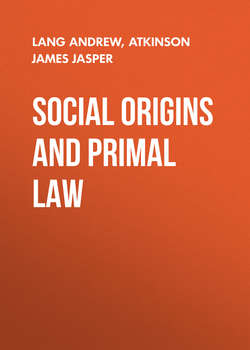Читать книгу Social Origins and Primal Law - Lang Andrew - Страница 31
CHAPTER III
TOTEMS WITHIN THE PHRATRIES
DR. DURKHEIM ON THE ARUNTA
ОглавлениеI had written on this topic in the Fortnightly Review (June, 1899), and in another chapter of this book ('The Origin of Totemism'), before I saw the essay of Professor Durkheim, of Bordeaux, Sur le Totémisme.116 It is encouraging to find that Dr. Durkheim, independently, has worked out the same theory – namely, that the Arunta are not in the primitive stage of Totemism, but represent a very peculiar divergence from the type, and that their historical legends (more or less accepted by Mr. Frazer and Mr. Spencer) are mainly myths, told to account for certain facts in their social arrangements. We are not to reason from their single case, says Dr. Durkheim, as against the great mass of our knowledge of Totemism and totemistic exogamy and exophagy. 'In place of being a perfectly pure example of the totemistic régime, is not Arunta Totemism a later and disfigured (dénaturée) development?' For many reasons, says Dr. Durkheim, 'the Arunta are among the most advanced of the Australian peoples,'117 and he gives his grounds for this opinion, some of which I had already adduced in 1899. Entering into detail, Dr. Durkheim readily shows that, though the Arunta now permit marriage between persons of the same totem (which is not hereditary on either side, but casual), they are, for all that, exogamous, in a fashion resulting from precise Totemism in their past.
They may not marry within the two primary divisions (which Dr. Durkheim styles 'phratries'). Each phratry contains two (sometimes four) other 'classes' (exogamous), and phratries arose in the combination of 'two elementary exogamous totem groups' – as I have already suggested. Now phratries, we have agreed with Mr. Howitt and Mr. Fison, were, in all probability, themselves originally totemic. Mr. Frazer also says, 'We should infer that the objects from which the Australian phratries take their names were originally totems. But there seems to be direct evidence that both the phratries and subphratries actually retain, in some tribes, their totems.'118 If the opinion be correct, the phratries of the Arunta, which regulate their marriages, were originally local totem groups. On my system, then, namely, that totem kins were originally, or very early became, exogamous, were exogamous before 'phratries' arose, and before the so-called 'bisection' was made, then the Arunta organisation was originally that of exogamous Totemism. At first, though not now, totems regulated Arunta marriages.
Dr. Durkheim, in the passage cited, says that the two exogamous phratries are composed of 'two elementary totem groups, également exogames.'119 Dr. Durkheim, who here is of my opinion, writes, 'It is not true that, among the Arunta, the totem has always been' (as it is now) 'without influence on marriages, nor, above all, is it true that Totemism, generally, implied endogamy.' Yet, according to Arunta myth, the ancestors of the 'dream-time' (Alcheringa) were endogamous, as a general rule, and, as a general rule, were endophagous, ate their totem animals or plants. The ancestors of their traditions fed on their own totems, 'as if by a functional necessity,' say Messrs. Spencer and Gillen. But this simply cannot be true, for each totem is not in season, (plums, for instance), or accessible, all the year through, and, if it were, it would be exterminated by endophagy. The traditions, again, do not represent the men of the totem groups as really and religiously endogamous. They exercised marital privileges, not only over the women of their totem group, but over any other woman they could come across. Certain totem groups are represented in the legends as wandering across the land, the men living with women of their totem group, while 'there is nothing to show definitely that marital relations were prohibited between individuals of different totems.' The men accepted the caresses of such women of other totems as they encountered; but their habitual mates were the women of their own totem.120 In the alleged state of perpetual trek, the wives were naturally, in the opinion of the myth makers, of the group. At present an Arunta marries in or out of his totem; as he pleases.
116
L'Année Sociologique, 1900-1901, pp. 82-121.
117
Ibid. v. 89-90.
118
Totemism, p. 83.
119
L'Année Sociologique, v. 92.
120
Spencer and Gillen, p. 419.
